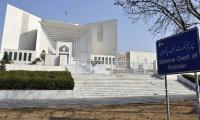It is now a fight between coronavirus pandemic and massive unemployment wave and like any other country around the world; Pakistan too would be facing this huge challenge in coming weeks and months, which required a coordinated policy and clear direction. What we need is social distancing not political distancing. The latter could be lethal to meet the challenge.
Pakistan may also face extra pressure as around 50,000 overseas Pakistanis facing unemployment, mostly in the Middle East countries will likely to return and look for new opportunities.
With virus peak yet to come and expected from April 16 to 30th, the government of Prime Minister Imran Khan, in coordination with the provincial governments is trying hard to address both, virus and hunger.
While easing restrictions on certain sectors is step which should be seen in the light of the challenges ahead, Sindh Chief Minister Murad Ali Shah announced Wednesday measures for tough lockdown as well as SOPs for sectors including pick and drop service for labourers or employees concerned.
These sectors including construction and its related industries besides export sector which he along with others had agreed in Tuesday’s meeting of National Coordination Committee (NCC).
If 110,000 people have already died around the world of the deadly virus, over 10 million had also lost their jobs, too. The danger is that both these tally will go up and no one knows where it will stop but surely the first half of the year 2020 belongs to the worst ever crisis in 100 years.
Pakistan’s unemployment challenges also depend on our export and how government establishes its writ through their decisions. If on the one hand it has announced relief for different sector but on the other if it fails in prohibiting the private sector from massive layoff, the relief would be meaningless. Secondly, without transport how the common daily wagers will reach to the workplace. At the same time, there is lot more risk involved if government allows public transport, the most vulnerable sector to spread the virus. But in phases they can allow Metro or online private bus service with certain strict SOPs in days to come. But rail operation and some other sectors will still take some time.
When on Tuesday, Pakistan recorded its 100th death and joined the 40 countries with over 100 deaths; it still considered itself lucky to be far behind many countries where daily death toll is between 300 to 500 or even more. Even if we are far behind in ‘testing’ it is still a success story and could have been better had we taken the ‘lockdown’ decision soon after the first death on February 26.
One can have difference of opinion but the fact remains that when Prime Minister Imran Khan after taking all the four provincial chief ministers, Azad Kashmir and Gilgit-Baltistan governments into confidence, extended the ‘lockdown’ for two more weeks, he also announced measures to meet the challenge of possible unemployment and fear of hunger challenge. From Benazir Income Support Programme (BISP) to newly-named Ehsaas Programme, the government has addressed the issue and paid the first of four packages of Rs12,000 cash to the registered poor people.
The prime minister Tuesday took a bold decision in easing the lockdown for certain sectors for resuming economic activity in a limited manner but it certainly involved a lot of risk as well because the peak of the deadly virus is yet to come and predictions are that it could hit from April 15 to 30th.
There can be two opinions about the PM’s decision but if the federal and provincial governments manage to enforce SOPs, strictly, Pakistan can become a success story among the few countries which eased the lockdown for normalcy.
The recent decision taken by the National Coordination Committee, headed by prime minister and all the chief ministers as its members reached consensus on 98 percent method to ease the lockdown while the ban on public transport, railways, restaurants, marriage halls, big and small shopping plazas, political or religious congregations, playgrounds and even on small traders and shops will continue.
But what if the virus really hits at its peak, are we ready for the challenge ahead? As a nation, we only react and never act and get ourselves ready for the worst and as a nation, we hardly follow rules and SOPs.
While one appreciates prime minister or NCC decisions keeping in view the challenges of unemployment and hunger, it would be unfair to give the credit to the first timely decision of the federal government for not letting a group of stranded Pakistanis to return from Wuhan, China, where the unknown ‘coronavirus’ first surprised the world. Initially, that decision was criticised by cross section of the society and the media but it proved right.
Similarly, it would also be unfair not to give credit to the Sindh government and Chief Minister Murad Ali Shah, going for lockdown after the first death reported on February 26. Had the federal government followed its initial decision and closed the Taftan border or followed the proper testing before allowing pilgrims to enter the country, we might even had not allowed virus to spread. This was followed by a wrong decision in allowing Raiwind congregation by Tableeghi Jamaat.
The tragic part was that some late decisions led to political point scoring and blame game and as a result lockdown became a political issue. Both, federal and provincial governments also failed in controlling the massive price hike in corona-hit Pakistan and at the same time we got ourselves involved in ‘sugar and wheat’ inquiry report by the FIA.
There is little doubt that virus could have hit the city like Karachi, with over 2.5 million population, half of which lives in over 8,000 ‘katchi abadies’ badly had government not went for lockdown after virus cases started coming from ‘Zaireen’. They traced people and got them tested. It can still be ‘Catch-22’ like situation, if people start breaking the lockdown and come on streets, ignoring social distancing.
Except in ‘Raiwind case’, the Punjab government also did an excellent job and so was Khyber Pakhtunkhwa. So, it was the first lockdown, which enabled the NCC, to taken a bold initiative of allowing certain sectors like construction industry to open.
However, the holy month of Ramazan will be the real test for the National Coordination Committee and all the provincial governments, Azad Kashmir and Gilgit-Baltistan governments.
It may nearly be impossible to maintain social distancing though, the religious leaders who have announced their decision and plan for Ramazan saying they would try to follow the SOPs. Secondly, we will see heavy rush just before Iftari in and around shops, fruit markets etc.
Prime Minister Imran Khan and Religious Affairs Minister Noorul Haq Qadri will be meeting ulema from different sects for a broader consensus on Ramazan, which is a must.
We are lucky to be far behind countries like China, the United States, Spain, Italy, England or Germany, where the death toll is in thousands. Experts are giving different opinions why virus did not spread like in the West and why our death toll after three months had touched 100 Tuesday, but unlike in Europe we might be late in lockdown but reacted after stranded Pakistanis asked to return from Wuhan, China.
There is no doubt that prime minister has taken a huge risk in easing the lockdown in a good spirit and after taking all the four chief ministers into confidence. If we will be able to control the coronavirus spread in Ramazan with controlled lockdown, social distancing and enforcing SOPs during the holy month, who knows we may be able to celebrate Eid, while remembering those who died due to this mysterious coronavirus even if we won’t be able to observe it in a traditional manner.
The writer is a senior columnist and analyst of Geo, The News and Jang.
Twitter: @MazharAbbasGEO
Khyber Pakhtunkhwa Chief Minister Ali Amin Gandapur. —Radio PakistanISLAMABAD. All the witnesses have been...
Former prime minister, MNA Raja Pervez Ashraf speaking on the occasion of World Press Freedom Day at the National...
Poster of “7th Sky Entertainment” drama serial “Khumar”. — YouTube/Geo News KARACHI: The last episode of...
Mahr Sahibzad Khan. — PMD websiteISLAMABAD: Prime Minister Shehbaz Sharif approved the summary for re-employment of...
Pashtunkhwa Mili Awami Party Chairman Mahmood Khan Achakzai is participating in a protest in Pishin against alleged...
In this screengrab, Agriculture Minister Ashiq Hussain Kirmani chairs a meeting, Punjab Agriculture Secretary Iftikhar...







